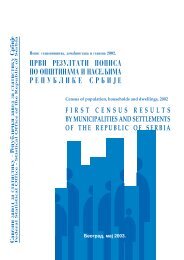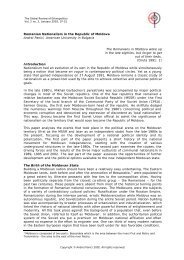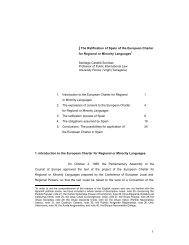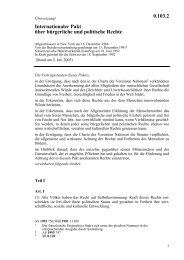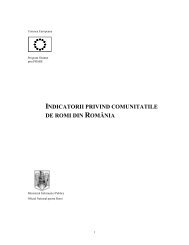Final Report of the International Commission on the - Minority Rights ...
Final Report of the International Commission on the - Minority Rights ...
Final Report of the International Commission on the - Minority Rights ...
Create successful ePaper yourself
Turn your PDF publications into a flip-book with our unique Google optimized e-Paper software.
<str<strong>on</strong>g>the</str<strong>on</strong>g> procedure followed elsewhere. On May 2, 1944, <str<strong>on</strong>g>the</str<strong>on</strong>g> Jews were summ<strong>on</strong>ed by <str<strong>on</strong>g>the</str<strong>on</strong>g> police to appear <str<strong>on</strong>g>the</str<strong>on</strong>g><br />
following morning at 6:00a.m. at police headquarters al<strong>on</strong>g with all members <str<strong>on</strong>g>of</str<strong>on</strong>g> <str<strong>on</strong>g>the</str<strong>on</strong>g>ir families. One<br />
pers<strong>on</strong> from each family was <str<strong>on</strong>g>the</str<strong>on</strong>g>n allowed to return home in <str<strong>on</strong>g>the</str<strong>on</strong>g> company <str<strong>on</strong>g>of</str<strong>on</strong>g> a policeman to pick up <str<strong>on</strong>g>the</str<strong>on</strong>g><br />
essential goods allowed by <str<strong>on</strong>g>the</str<strong>on</strong>g> authorities. After this <str<strong>on</strong>g>the</str<strong>on</strong>g> Jews were transferred to an unfinished building<br />
that had nei<str<strong>on</strong>g>the</str<strong>on</strong>g>r doors nor windows.<br />
The Jews <str<strong>on</strong>g>of</str<strong>on</strong>g> Ciuc County, including those <str<strong>on</strong>g>of</str<strong>on</strong>g> Miercurea Ciuc, were rounded up under <str<strong>on</strong>g>the</str<strong>on</strong>g> general<br />
command <str<strong>on</strong>g>of</str<strong>on</strong>g> Ernö Gaáli, <str<strong>on</strong>g>the</str<strong>on</strong>g> prefect <str<strong>on</strong>g>of</str<strong>on</strong>g> Ciuc County; József Abraham, <str<strong>on</strong>g>the</str<strong>on</strong>g> deputy prefect; Gerö Szász, <str<strong>on</strong>g>the</str<strong>on</strong>g><br />
mayor <str<strong>on</strong>g>of</str<strong>on</strong>g> Miercurea Ciuc; Pál Farkas, <str<strong>on</strong>g>the</str<strong>on</strong>g> city’s chief <str<strong>on</strong>g>of</str<strong>on</strong>g> police; and Lt.-Col. Tivadar Lóhr, <str<strong>on</strong>g>the</str<strong>on</strong>g><br />
commander <str<strong>on</strong>g>of</str<strong>on</strong>g> <str<strong>on</strong>g>the</str<strong>on</strong>g> gendarmes at Miercurea Ciuc. Like <str<strong>on</strong>g>the</str<strong>on</strong>g> city and county leaders <str<strong>on</strong>g>of</str<strong>on</strong>g> Trei Scaune County,<br />
<str<strong>on</strong>g>the</str<strong>on</strong>g>se <str<strong>on</strong>g>of</str<strong>on</strong>g>ficials too had attended <str<strong>on</strong>g>the</str<strong>on</strong>g> Tîrgu Mureş meeting with Endre.<br />
The c<strong>on</strong>diti<strong>on</strong>s in <str<strong>on</strong>g>the</str<strong>on</strong>g> Sfântu Gheorghe ghetto, which was under <str<strong>on</strong>g>the</str<strong>on</strong>g> immediate command <str<strong>on</strong>g>of</str<strong>on</strong>g> an<br />
unidentified SS <str<strong>on</strong>g>of</str<strong>on</strong>g>ficer, were harsh. The Jews from this ghetto were transferred to <str<strong>on</strong>g>the</str<strong>on</strong>g> ghetto <str<strong>on</strong>g>of</str<strong>on</strong>g> Reghin a<br />
week later.<br />
Sighetu Marmaţiei. Although geographically Maramureş County was part <str<strong>on</strong>g>of</str<strong>on</strong>g> Nor<str<strong>on</strong>g>the</str<strong>on</strong>g>rn Transylvania,<br />
for dejewificati<strong>on</strong> purposes it was c<strong>on</strong>sidered part <str<strong>on</strong>g>of</str<strong>on</strong>g> Carpatho-Ru<str<strong>on</strong>g>the</str<strong>on</strong>g>nia and Nor<str<strong>on</strong>g>the</str<strong>on</strong>g>astern Hungary. Since<br />
it c<strong>on</strong>tained <strong>on</strong>e <str<strong>on</strong>g>of</str<strong>on</strong>g> <str<strong>on</strong>g>the</str<strong>on</strong>g> largest c<strong>on</strong>centrati<strong>on</strong>s <str<strong>on</strong>g>of</str<strong>on</strong>g> Orthodox and Hasidic Jews in Hungary, <str<strong>on</strong>g>the</str<strong>on</strong>g> German and<br />
Hungarian <str<strong>on</strong>g>of</str<strong>on</strong>g>ficials were particularly anxious to clear this area <str<strong>on</strong>g>of</str<strong>on</strong>g> Jews.<br />
The details <str<strong>on</strong>g>of</str<strong>on</strong>g> <str<strong>on</strong>g>the</str<strong>on</strong>g> anti-Jewish measures enacted in Maramureş County, as in Carpatho-Ru<str<strong>on</strong>g>the</str<strong>on</strong>g>nia as a<br />
whole, were adopted at <str<strong>on</strong>g>the</str<strong>on</strong>g> c<strong>on</strong>ference held in Munkács <strong>on</strong> April 12, 1944. Maramureş County and <str<strong>on</strong>g>the</str<strong>on</strong>g><br />
municipality <str<strong>on</strong>g>of</str<strong>on</strong>g> Sighetu Marmaţiei were represented at <str<strong>on</strong>g>the</str<strong>on</strong>g> Munkács C<strong>on</strong>ference by László Illinyi, <str<strong>on</strong>g>the</str<strong>on</strong>g><br />
deputy prefect; Sándor Gyulafalvi Rednik, <str<strong>on</strong>g>the</str<strong>on</strong>g> mayor <str<strong>on</strong>g>of</str<strong>on</strong>g> Sighetu Marmatiei; Lajos Tóth, <str<strong>on</strong>g>the</str<strong>on</strong>g> chief <str<strong>on</strong>g>of</str<strong>on</strong>g><br />
police; Col. Zoltán Agy, <str<strong>on</strong>g>the</str<strong>on</strong>g> commander <str<strong>on</strong>g>of</str<strong>on</strong>g> <str<strong>on</strong>g>the</str<strong>on</strong>g> local legi<strong>on</strong> <str<strong>on</strong>g>of</str<strong>on</strong>g> gendarmes; and Col. Sárvári, <str<strong>on</strong>g>the</str<strong>on</strong>g><br />
commander <str<strong>on</strong>g>of</str<strong>on</strong>g> District IV <str<strong>on</strong>g>of</str<strong>on</strong>g> <str<strong>on</strong>g>the</str<strong>on</strong>g> gendarmerie. On <str<strong>on</strong>g>the</str<strong>on</strong>g> morning <str<strong>on</strong>g>of</str<strong>on</strong>g> April 15, Illinyi held a meeting in<br />
Sighetu Marmaţiei with all <str<strong>on</strong>g>the</str<strong>on</strong>g> top <str<strong>on</strong>g>of</str<strong>on</strong>g>ficials <str<strong>on</strong>g>of</str<strong>on</strong>g> <str<strong>on</strong>g>the</str<strong>on</strong>g> county to discuss <str<strong>on</strong>g>the</str<strong>on</strong>g> details <str<strong>on</strong>g>of</str<strong>on</strong>g> <str<strong>on</strong>g>the</str<strong>on</strong>g> ghettoizati<strong>on</strong><br />
process, including <str<strong>on</strong>g>the</str<strong>on</strong>g> selecti<strong>on</strong> <str<strong>on</strong>g>of</str<strong>on</strong>g> ghetto sites. That same afterno<strong>on</strong> Tóth chaired a meeting <str<strong>on</strong>g>of</str<strong>on</strong>g> <str<strong>on</strong>g>the</str<strong>on</strong>g><br />
civilian, police and gendarmerie <str<strong>on</strong>g>of</str<strong>on</strong>g>ficials <str<strong>on</strong>g>of</str<strong>on</strong>g> Sighetu Marmaţiei at which <str<strong>on</strong>g>the</str<strong>on</strong>g> details <str<strong>on</strong>g>of</str<strong>on</strong>g> <str<strong>on</strong>g>the</str<strong>on</strong>g> operati<strong>on</strong> were<br />
reviewed. This meeting also established <str<strong>on</strong>g>the</str<strong>on</strong>g> twenty commissi<strong>on</strong>s in charge <str<strong>on</strong>g>of</str<strong>on</strong>g> rounding up <str<strong>on</strong>g>the</str<strong>on</strong>g> Jews. Each<br />
commissi<strong>on</strong> c<strong>on</strong>sisted <str<strong>on</strong>g>of</str<strong>on</strong>g> a police <str<strong>on</strong>g>of</str<strong>on</strong>g>ficer, gendarmes, and <strong>on</strong>e civil servant.<br />
The ghetto <str<strong>on</strong>g>of</str<strong>on</strong>g> Sighetu Marmaţiei was established in two peripheral secti<strong>on</strong>s <str<strong>on</strong>g>of</str<strong>on</strong>g> <str<strong>on</strong>g>the</str<strong>on</strong>g> city, inhabited<br />
primarily by <str<strong>on</strong>g>the</str<strong>on</strong>g> poorer strata <str<strong>on</strong>g>of</str<strong>on</strong>g> Jewry. The ghetto held over 12,000 Jews, <str<strong>on</strong>g>of</str<strong>on</strong>g> whom a little over 10,000<br />
came from <str<strong>on</strong>g>the</str<strong>on</strong>g> city itself. The o<str<strong>on</strong>g>the</str<strong>on</strong>g>rs were brought in from many <str<strong>on</strong>g>of</str<strong>on</strong>g> <str<strong>on</strong>g>the</str<strong>on</strong>g> mostly Romanian-inhabited<br />
villages in <str<strong>on</strong>g>the</str<strong>on</strong>g> districts <str<strong>on</strong>g>of</str<strong>on</strong>g> Dragomireşti, Maramureş, Ocna-Şugatag, Ökörmezö (now Ukraine), Rahó<br />
(now Ukraine), Técsö (now Ukraine), and Vişeu de Sus.<br />
The ghetto was extremely crowded, with almost every room in every building, including <str<strong>on</strong>g>the</str<strong>on</strong>g> cellars<br />
and attics, occupied by fifteen to twenty-four people. The windows <str<strong>on</strong>g>of</str<strong>on</strong>g> <str<strong>on</strong>g>the</str<strong>on</strong>g> buildings at <str<strong>on</strong>g>the</str<strong>on</strong>g> edges <str<strong>on</strong>g>of</str<strong>on</strong>g> <str<strong>on</strong>g>the</str<strong>on</strong>g><br />
ghetto had to be whitewashed to prevent <str<strong>on</strong>g>the</str<strong>on</strong>g> ghetto inhabitants from communicating with n<strong>on</strong>-Jews. To<br />
fur<str<strong>on</strong>g>the</str<strong>on</strong>g>r assure <str<strong>on</strong>g>the</str<strong>on</strong>g> isolati<strong>on</strong> <str<strong>on</strong>g>of</str<strong>on</strong>g> <str<strong>on</strong>g>the</str<strong>on</strong>g> Jews, <str<strong>on</strong>g>the</str<strong>on</strong>g> ghetto was surrounded by barbed wire and guarded not <strong>on</strong>ly<br />
by <str<strong>on</strong>g>the</str<strong>on</strong>g> local police but also by a special unit <str<strong>on</strong>g>of</str<strong>on</strong>g> fifty gendarmes, assigned from Miskolc, under <str<strong>on</strong>g>the</str<strong>on</strong>g><br />
command <str<strong>on</strong>g>of</str<strong>on</strong>g> Col<strong>on</strong>el Sárvári. The commander <str<strong>on</strong>g>of</str<strong>on</strong>g> <str<strong>on</strong>g>the</str<strong>on</strong>g> ghetto was Tóth; József K<strong>on</strong>yuk, <str<strong>on</strong>g>the</str<strong>on</strong>g> head <str<strong>on</strong>g>of</str<strong>on</strong>g> <str<strong>on</strong>g>the</str<strong>on</strong>g><br />
local firefighters, acted as his deputy. The ghetto was administered under <str<strong>on</strong>g>the</str<strong>on</strong>g> general authority <str<strong>on</strong>g>of</str<strong>on</strong>g> Sándor<br />
Gyulafalvi Rednik, whose expert adviser <strong>on</strong> Jewish affairs was Ferenc Hullmann. It was Hullmann who<br />
rejected practically all <str<strong>on</strong>g>of</str<strong>on</strong>g> <str<strong>on</strong>g>the</str<strong>on</strong>g> requests forwarded by <str<strong>on</strong>g>the</str<strong>on</strong>g> Jewish Council asking for an improvement in <str<strong>on</strong>g>the</str<strong>on</strong>g><br />
lot <str<strong>on</strong>g>of</str<strong>on</strong>g> <str<strong>on</strong>g>the</str<strong>on</strong>g> ghetto inhabitants.<br />
The Jewish Council c<strong>on</strong>sisted <str<strong>on</strong>g>of</str<strong>on</strong>g> Rabbi Samu Danzig, Lipót Joszovits, Jenö Keszner, Ferenc Krausz,<br />
Mór Jakobovits, and Ignátz Vogel. Like every o<str<strong>on</strong>g>the</str<strong>on</strong>g>r ghetto, Sighetu Marmatiei’s also had a “mint” where




